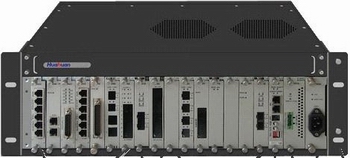Products Guide
H9MO-LMXE+.V2 Integrated Access Multiplexer

Product Overview
H9MO-LMXE+.V2, which was developed by Huahuan, provides various features and applies todifferent networking, meeting customers' requirements. The H9MO-LMXE+.V2 is an integrated access multiplexer of Huawei. Traditional pulse code modulation(PCM) devices need to work with optical transmission devices. Based on the MSTP architecture, the H9MO-LMXE+.V2 integrates SDH transmission and PCM services.Traditional networking must use PCM and SDH devices independently.
H9MO-LMXE+.V2, which is deployed between the backbone network and access network,provides various service ports and large-capacity transmission capabilities.With the small size, lower power consumption, high reliability, H9MO-LMXE+.V2 is easy to maintain and manage, which saves space in the equipment room and minimizes the CAPEX and OPEX.
H9MO-LMXE+.V2 is widely used in power, oil, and transportation industries, and for municipal NM and water resources monitoring. It supports transmission of monitoring, remote control, and alarm data signals, and provides dispatching phone and administrative phone services on the transport network.
H9MO-LMXE+.V2 supports the following transmission modes:
● Optical port transmission with the rate of STM-1/STM-4/STM-16
● E1 port transmission
H9MO-LMXE+.V2 supports the following services on different ports:
● PCM voice services on FXO, FXS, hotline, magnet, 2/4-wire audio ports and EM
● Low-speed synchronous data services (N x 64 kbit/s V.35, X.21, and C37.94data), asynchronous data services (RS-232/V.24/V.28, RS-422, and RS-485/V.11), 64kbit/s G.703 co-directional data/C37.94 teleprotection interface, Dry contact interface, High voltage protection interface etc.
● PDH services through the E1, E3/DS3 ports.
● Ethernet services including switching, channel Ethernet services and FE/GEservices.
● Support Layer-3 routingcard, RS-232 conference, 2-wire/4-wire audio voice conference, analog telephone conference.
Features
Cross-connection capacity | STM-1: 20 x 20 VC-4s, 60 x 60 VC-3s, 1260 x 1260 VC-12s STM-4: 32 x 32 VC-4s, 96 x 96 VC-3s, 2016 x 2016 VC-12s STM-16: 96 x 96 VC-4s, 96 x 96 VC-3s, 2016 x 2016 VC-12s |
Cross-connection direction | Group to tributary, tributary to group, group to group, tributary to tributary, internal 64 kbit/s timeslot cross-connection of PCM cards |
Cross-connection mode | bidirectional, unidirectional, multicast/broadcast and loopback |
Specifications
Optical protection capability | SNCP for VC-12, VC-3, and VC-4 services (Protection switching is implemented within 50 ms) Linear 1+1 MSP, two-fiber unidirectional MSP at the STM-1 and STM-4 levels |
Power redundant supply | Two power cards work in 1+1 backup mode. |
NM channel | External DCN DCC NM channel: select any group from D1-D3, D4-D6, D7-D9, and D10-D12 E1 NM channel: assigned to any VC-12 of the cross-connection card or STM card, or E1 port on the E1 interface card. EoE in-band NM channel N*64 kbit/s in-band monitoring Monitoring channels of PCM cards (Sa in-band monitoring) |
E1 protection capability | Support 1+1 protection between any two E1 and 56 pairs protection can be configured at most |
Chassis dimention (W x D x H) | 440mm×280mm×130mm |
Power supply | DC power supply: -48 V DC AC power supply: 220 V/110 V AC |
Maximum Power Consumption | Typical application: ≤85W |
Operating environment (temperature, humidity) | -15°C ~ +55°C, 0-95%RH (non-condensing) |
Storage environment (temperature, humidity) | -40°C ~ +105°C, 0-95%RH (non-condensing) |
Typical Application

Standard Compliance
Items | Standards and Protocols |
SDH optical port | G.957, Frame structure: G.707 |
C37.94 optical port | IEEE C37.94TM-2002 |
Audio voice port | G.711, G.713 |
Asynchronous data port | V.24, V.11 |
Co-directional data port | G.703 |
E1, E3/DS3 port | G.703, G.704 |
Clock port | G.823 |
Ethernet port | IEEE 802 G.7041/G.704 2/G.7043 and G.8040 |

 Login
Login
 IP/MPLS/IPRAN
IP/MPLS/IPRAN Location:
Location:

 免费注册
免费注册



